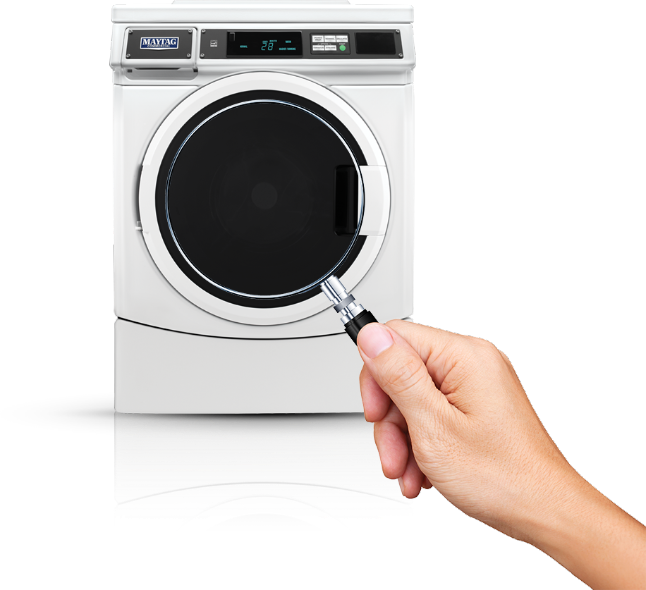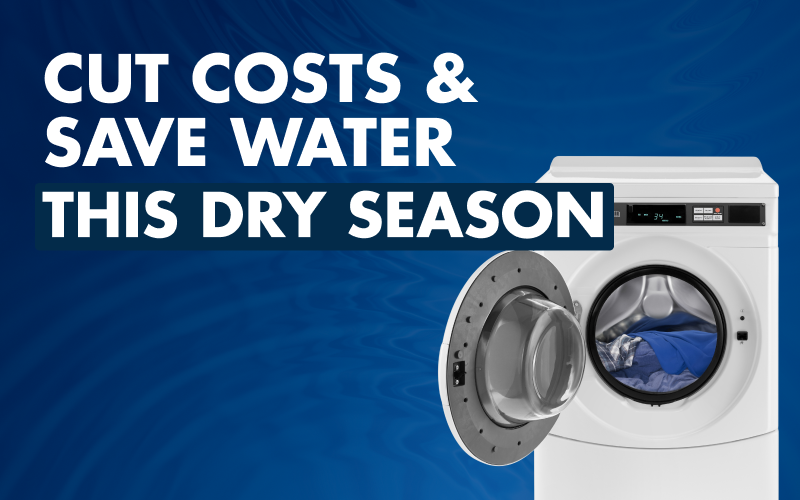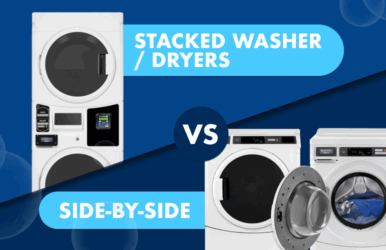Speak with us today: 1800 629 824
Tetris, Jenga and you: Why you can’t stack commercial washing machines

Stacking stuff is great. Pancakes, Pringles, patio furniture. But stacking commercial washing machines? Can’t be done.
Sure, the dream is to save space. But stacking washing machines on top of washing machines just can’t be done.
Let’s break down why stacking your commercial washing machines is a truly bonkers idea – and what you should be doing instead.
Reason 1: It’s a structural nightmare
We’re not going to sit here and pretend DIY stacking doesn’t happen.
We know it does. Especially in smaller laundries or busy setups that are trying to squeeze every last bit of use out of their floor plan.
We’re not here to judge. But we are disappointed.
Here’s the cold, hard truth: commercial washing machines aren’t meant to support the weight of another washing machine perched on top. And, deep down, you know that.
Spin cycles with 9kg of washing plus 40 Liters of water sloshing around up high amplify every little imperfection in your homemade tower, and before you know it, you’ve got a shifting, shaking monolith threatening to topple over.
Instead of risking the whole operation, go with machines that are meant to be stacked. Like the Maytag Commercial MLE/G22PN washer/dryer stack. These units are built tough, with the weighty washing machine down bottom and the lighter dryer built into the unit up top, with reinforced frames and shock absorption designed to take the heat (and the spin).
Reason 2: Vibration equals machine damage
Let’s not sugarcoat it – commercial washers and dryers spin like there’s no tomorrow.
These aren’t your nan’s pastel pink top-loader from the 80s. We’re talking serious mechanical muscle here.
And when you’ve got 40 litres of water spinning around above the centre of gravity, that movement can make major issues.
Any misalignment will cause internal components to shake loose. Worse still, the damage doesn’t just hit the top unit. Both machines cop the brunt of the vibration stress, which means double the damage, double the downtime and double the dollars down the drain.
Want to avoid chewing through your repair budget? While you can’t stack a commercial washing machine on top of another commercial washing machine – you sure can stack dryers on top of each other – and we’ve got the perfect machine designed for the job: Maytag Commercial’s MLE/G27PN. These stacked dryer/dryer bad boys are designed to handle the heat and the hustle. Without rattling themselves into early retirement.
Reason 3: Increased wear and tear
When you DIY stack a washing machine on top of another washing machine, you’re basically asking the bottom of the machine to carry a back-breaking load it was never meant for.
It’s like putting a fridge on top of a bar stool. Sure, it might stay up… for a while.
But eventually? Gravity wins.
Instead, treat your gear with a little respect. Go with stack systems that are built to carry the load, like the Maytag commercial MLE/G22PD, with coin/card options. These machines distribute weight evenly, with the washer on the bottom and dryer up top, ensuring an extended life of both machines.
Bonus: you make money off every cycle while you’re at it.
Reason 4: You’ll wave goodbye to your warranty
Here’s something people often forget when they go rogue: most manufacturers don’t cover damage from DIY setups.
If you go rogue with your installation and a machine fails? That’s on you. You’ll be footing the bill for repairs, replacements and downtime.
So while you think you’re saving money and space by stacking 2 washing machines on top of each other, you’re actually signing up for a very expensive game of chance. Instead, stick with machines that come with the manufacturer’s blessing – like the ADC ADG30x2Ri-PN 13kg Stack Dryer/Dryer.
Two big, efficient drying drums. Zero compliance headaches. And a warranty that’s worth way more than the paper it’s printed on.
Give your laundry the structure it deserves – without playing appliance Jenga. Check out our full range of stackable washers and dryers here.
Every Australian state has its own set of water restrictions, and staying compliant is non-negotiable. The key is to know the rules and adjust where needed.
Common restrictions that affect commercial laundries include:
- Limits on water usage during certain times of day
- Requirements for using recycled water
- Mandatory reductions in daily water consumption
So check with your local council for the full rundown, and make sure your laundry is ahead of the game.
Need a machine that’ll keep your laundry sustainable this summer? Check out our Maytag Commercial range for the best of the best.
Recent Articles
Stacked Washer / Dryers vs Side-By-Side: Which is Right For Your Laundry Room?
When space, uptime and efficiency matter, the way you configure your laundry is just as important as the machin....Read More
Cutting Costs and Conserving Water — How Laundries can Lead This dry Season
Across Australia, communities are adjusting to drier months with rostered sprinkler days, shorter showers and r....Read More






